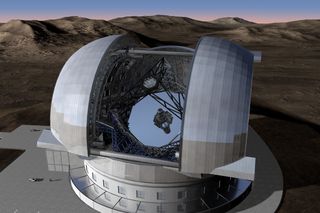Eyeing The Hidden Universe
"Both projects [two telescopes, one in the North, the other South; the Thirty Meter/The Giant Magellan] finally woke up to the fact they are being creamed by the European 39-meter [European Extremely Large Telescope in Chile]."
Matt Mountain, president, Association of Universities for Research in Astronomy
"The ELT will produce discoveries that we simply cannot imagine today, and it will inspire people around the world to think about science, technology and our place in the universe."
"As much as we astronomers always aim for ever bigger telescopes, the core purpose of such a revolutionary project as the ELT is to find the right balance between scientific capability and cost efficiency."
"ESO has always managed to lead ground-based astronomy and built front-line telescopes thanks to this approach."
"With the new ELT design we can still satisfy the bold science goals and also ensure that the construction can be completed in only ten to eleven years. This will allow the ELT to operate simultaneously with the James Webb Space Telescope."
Tim de Zeeuw, ESO's Director General (European Southern Observatory)
 |
Top view 3-dimensional model European Extremely Large Telescope & enclosure.
(Image: © ESO)
|
Telescopes on American mountaintops such as Palomar, Kitt Peak and Mauna Kea until recently have been the ultimate telescopes on Earth. That will change in 2025 when the European Southern Observatory, a product of a multinational treaty organization, will first make use of a telescope destined to dwarf the universe-probing might of all others. Named the European Extremely Large Telescope, located on Cerro Paranal in Chile, a primary light-gathering mirror of 39 meters in diameter functions 13 times more powerfully than any other telescope now in use, anywhere in the world.
Should they ever be built, the Thirty Meter Telescope, to be constructed on Mauna Kea in Hawaii and the Giant Magellan on Cerro Las Campanas in Chile, represent two U.S.-led telescope projects capable of competing with the giant European telescope; both projects facing financial difficulties and political controversy. Should their eventual completion proceed, it would take at least a decade.
A protest movement arguing that decades of telescope building on Mauna Kea have served to pollute and desecrate a mountain sacred to Polynesian culture, violating the rights of native Hawaiins, has effectively stalled the Thirty Meter Telescope.
 |
| Many billions of years old, but still sparkling brightly, NGC 2257 is a globular cluster, the name given to the roughly spherical concentrations of stars that orbit galactic cores, but are often found far out from the centers in the halo areas of galaxies. NGC 2257 lies on the outskirts of the Large Magellanic Cloud (LMC), a satellite galaxy of our own Milky Way. The image is made from data taken with the Wide Field Imager instrument on the 2.2-meter MPG/ESO telescope at La Silla, as part of the ESO Imaging Survey project, which was planned to make public imaging surveys to identify targets for follow-up observations with the VLT. ESO |
Hundreds of millions of dollars are needed to finance both telescopes. The National Academy of Sciences in the U.S. is to be approached via a blue-ribbon panel by representatives of the two projects to ask for financial help. Part of the Decadal Survey where the astronomy community ranks priorities for allocating federal money, the panel has the kind of influence the telescope groups are hoping will be instrumental in allowing them to complete these two projects.
The survey's recommendations influence Congress and agencies such as the National Science Foundation.
With a high priority ranking, the National Science Foundation, traditionally funding ground-based observatories, could allocate greater funding for projects representing these two telescopes which will require at minimum a billion additional in funding to be completed, between them. To the present, about $600 million has been raised by the team behind the Giant Magellan Telescope from its partners, leading them now to search out an equivalent amount from the National Science Foundation.
The Hubble Space Telescope and its soon-to-be successor, the James Webb Space Telescope, provide
American astronomers with instruments in space, but Hubble is aging and the Webb telescope, once it reaches orbit in 2021, will take months to unfold itself. The Large Synoptic Survey Telescope now under construction in Chile, will be at the service of astronomers as well, but it is a mere eight meters in size, incapable of viewing deeply into space.
 |
One of most famous spiral galaxies is Messier 104,
widely known as the "Sombrero" because of its particular shape. It is
located towards the constellation Virgo, at a distance of about 30
million light-years.
ESO/IDA/Danish 1.5 m/R. Gendler and J.-E. Ovaldsen
|
American astronomers twenty years ago recognized a need for giant, ground-based telescopes. The California Institute of Technology and the University of California originated the Thirty Meter project. Since then the project has swelled to include Canada, Japan, China and India as viewing partners. The Carnegie Observatories began the Giant Magellan telescope, including now several universities and research institutes, along with South Korea, Australia and the State of Sao Paulo, in Brazil.
 |
| Extremely large telescopes are considered worldwide to be one of the highest priorities in ground-based astronomy. They will vastly advance astrophysical knowledge, allowing detailed studies of subjects including planets around other stars, the first objects in the Universe, supermassive black holes, and the nature and distribution of the dark matter and dark energy which dominate the Universe. ESO |
Labels: Astronomy, Giant Telescopes, Universe

0 Comments:
Post a Comment
<< Home